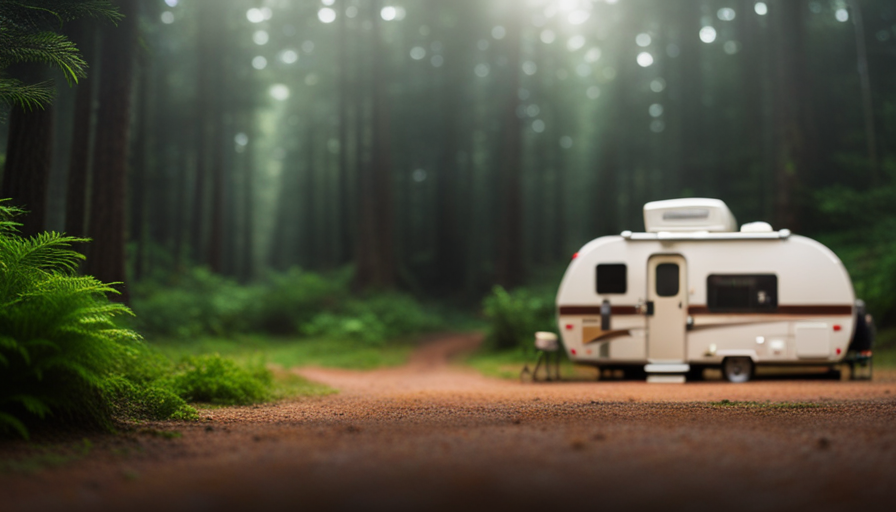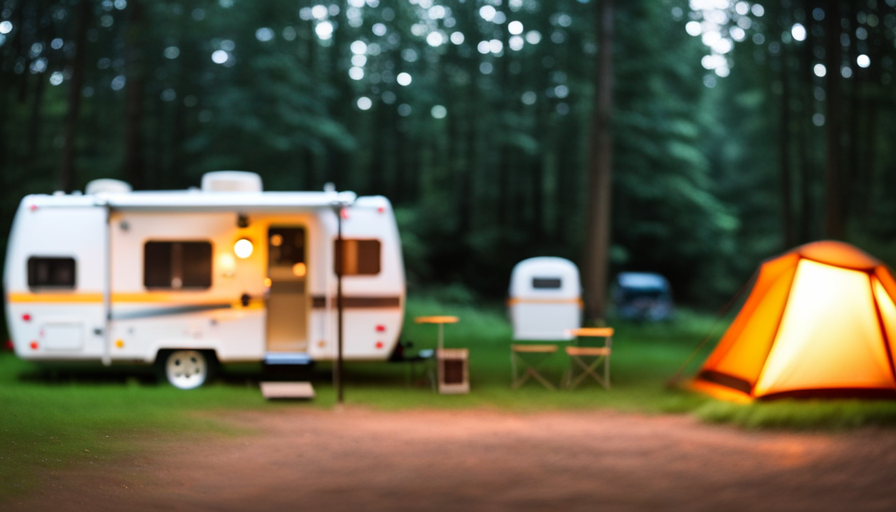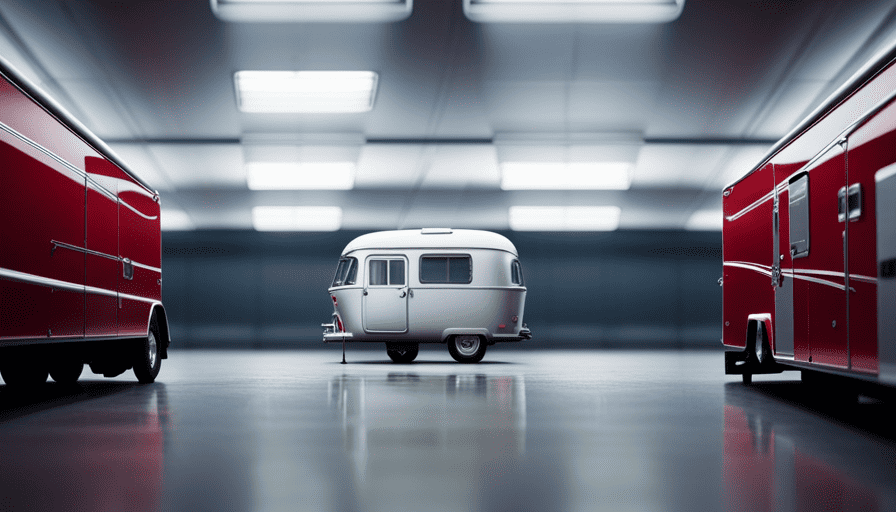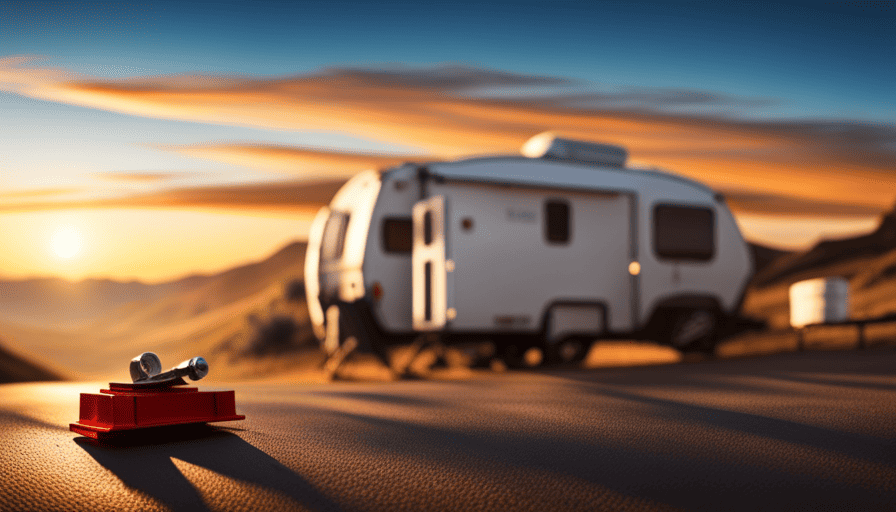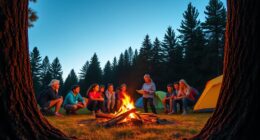Were you aware that almost 11 million people in the United States reside in RVs or campers? Indeed, the choice for a nomadic way of living is becoming increasingly popular, and the reasons for this shift are clear.
The freedom to travel and explore at your own pace is truly liberating. But the question remains, where can I park my camper to live near me? Well, fear not, fellow adventurers, because we’ve got you covered.
In this article, we’ll explore various options for parking your camper and living the dream. From national and state parks to private campgrounds and resorts, there are plenty of places to call home on the road.
We’ll also delve into the world of RV parks, public lands, and BLM areas, as well as the unique opportunities provided by Harvest Hosts and boondocking.
For those seeking a more temporary solution, we’ll even discuss options like temporary housing or RV communities, as well as utilizing Airbnb and vacation rentals.
So, buckle up and get ready to embark on the ultimate camper living experience!
Key Takeaways
- National and state parks offer serene and natural environments for living arrangements, with amenities such as electric and water hook-ups, picnic tables, restrooms, and showers.
- Private campgrounds and resorts provide scenic locations, a community atmosphere, and convenience, with spacious sites, full hookups, and additional amenities.
- Public lands and BLM areas offer opportunities for nature immersion and boondocking, allowing for a peaceful escape from daily life and the chance to enjoy the beauty of nature.
- Camping on working farms or ranches provides a unique agricultural lifestyle, with opportunities to park your camper on vineyards, animal farms, crop farms, organic farms, and horse ranches, and participate in daily farm activities and learn about sustainable practices.
National and State Parks
You can find excellent options for parking your camper near you at national and state parks, offering a serene and natural environment for your living arrangements.
National and state parks are popular choices for campers due to their beautiful landscapes and abundant amenities. Many campgrounds within these parks offer a range of facilities, such as electric and water hook-ups, picnic tables, restrooms, and showers. Some even provide Wi-Fi access, allowing you to stay connected while enjoying the great outdoors.
When it comes to camping regulations, national and state parks have specific rules in place to ensure the safety and enjoyment of all campers. These regulations may include restrictions on campfire usage, noise levels, pet policies, and length of stay. It’s important to familiarize yourself with these rules before choosing a park to park your camper.
RV campgrounds, which we will discuss in the next section, are another great option for parking your camper near you. These campgrounds often offer similar amenities to those found in national and state parks, with the added convenience of being specifically designed for RVs. So if you’re looking for a comfortable and convenient place to park your camper, RV campgrounds are definitely worth considering.
RV Campgrounds
When it comes to RV camping, finding designated areas with facilities for campers is key. Not only do these campgrounds provide essential amenities like water and electricity hookups, but they also offer a sense of community.
Connecting with fellow campers and sharing experiences can make your camping trip even more enjoyable. Additionally, there are various campground options available, allowing you to choose the one that best suits your preferences and needs.
Whether you prefer a rustic campground nestled in the woods or a modern campground with all the amenities, there is something for everyone.
Find designated areas with facilities for campers
If you’re looking for a convenient place to park your camper and have access to facilities, check out designated areas nearby. These areas are specifically designed for campers and offer a range of amenities to make your stay comfortable.
When parking your camper in these designated areas, it’s important to follow camping etiquette and safety precautions to ensure a positive experience for everyone. Be mindful of noise levels, clean up after yourself, and respect the rules and regulations of the campground.
By doing so, you can connect with fellow campers and enjoy a sense of community. Whether it’s swapping stories around a campfire or joining in on group activities, these designated areas provide the perfect opportunity to meet new people and create lasting memories.
Connect with fellow campers and enjoy a sense of community
Immerse yourself in the camping experience and embrace the sense of community by connecting with fellow campers and forging lasting friendships. When you connect with other campers, you not only create a support system but also have the opportunity to share your love for nature and outdoor activities.
Engage in conversations around the campfire, swap stories of your adventures, and discover new places to explore. Connect with nature lovers who can introduce you to amazing hiking trails, fishing spots, or even teach you a thing or two about birdwatching.
Being part of a camping community adds a special dimension to your experience, where you can learn from others and build memories together. Now that you have embraced the sense of community, let’s explore the next step: choosing from various campground options based on your preferences.
Choose from various campground options based on your preferences
Explore the diverse campground options available and find the perfect spot that aligns with your preferences. Whether it be a secluded site nestled among towering trees or a waterfront location with breathtaking views, national parks offer stunning natural beauty and a chance to immerse yourself in the great outdoors. You can choose from a wide range of campsites within these parks, each offering unique landscapes and recreational activities.
State parks also provide excellent camping opportunities, often with well-maintained facilities and access to hiking trails and wildlife viewing. Whether you prefer the rugged wilderness of a national park or the amenities and convenience of a state park, there are endless options to suit your camping style.
In the next section, we’ll explore private campgrounds and resorts, which offer additional amenities and services for a more luxurious camping experience.
Private Campgrounds and Resorts
Discover private campgrounds and resorts near you where you can park your camper and live comfortably. Whether you’re looking for temporary housing or vacation rentals, these private campgrounds and resorts provide the perfect solution for your camper living needs.
Here are four reasons why you should consider private campgrounds and resorts for your camper living experience:
-
Amenities: Private campgrounds and resorts offer a wide range of amenities to enhance your living experience. From swimming pools and hot tubs to fitness centers and laundry facilities, these campgrounds ensure that you have all the comforts of home.
-
Scenic Locations: Many private campgrounds and resorts are situated in beautiful, picturesque locations. Imagine waking up to stunning views of mountains, lakes, or forests right outside your camper door. These scenic locations provide the perfect backdrop for your camper living adventure.
-
Community Atmosphere: Private campgrounds and resorts often foster a strong sense of community. You can meet fellow campers, participate in social events, and build lasting friendships. It’s like having a neighborhood on wheels!
-
Convenience: Private campgrounds and resorts are conveniently located near popular attractions, shopping centers, and restaurants. You can easily explore the local area and enjoy all the amenities it has to offer.
Now that you know the benefits of private campgrounds and resorts, let’s delve into the next section about RV parks.
RV Parks
Get ready to embark on an RV adventure at remarkable RV resorts that offer a multitude of amenities and activities for your enjoyment. RV resorts are perfect for those looking for a comfortable and convenient place to park their camper for full-time living.
These resorts provide spacious RV sites with full hookups, including water, electricity, and sewer connections. Many resorts also offer additional amenities such as swimming pools, hot tubs, fitness centers, and even golf courses.
Living in an RV resort allows you to enjoy a sense of community, as you’ll be surrounded by fellow RV enthusiasts who share your love for the open road. You can participate in organized activities and events, meet new people, and make lifelong friends. Some RV resorts even have on-site restaurants, grocery stores, and laundry facilities, making it easy to live a comfortable and convenient lifestyle.
As you become more familiar with the RV lifestyle, you may also want to explore public lands and BLM areas for more adventurous camping experiences. These areas offer a different kind of camping, where you can immerse yourself in nature and enjoy the freedom of boondocking.
But before we delve into that, let’s take a closer look at the RV resorts that can provide you with a home away from home.
Public Lands and BLM Areas
When you’re ready to experience the beauty of nature and escape the hustle and bustle of daily life, public lands and BLM areas offer the perfect opportunity for you to immerse yourself in the great outdoors. Here are some reasons why you should consider camping on public lands:
-
National Forests: These expansive areas provide a serene setting for camping. You can find designated camping sites with basic amenities like picnic tables and fire pits, or you can venture into the backcountry for a more secluded experience. From towering trees to babbling brooks, national forests offer a wide range of landscapes to explore.
-
Dispersed Camping: If you prefer a more remote camping experience, dispersed camping is the way to go. You can set up camp anywhere within designated areas, allowing you to truly connect with nature. Whether you choose to camp near a tranquil lake or atop a scenic mountain, the choice is yours.
-
BLM Areas: The Bureau of Land Management (BLM) manages vast stretches of land that are open to camping. These areas often have fewer regulations, giving you more freedom to explore and enjoy the outdoors. From desert landscapes to sweeping plains, BLM areas offer diverse camping opportunities.
-
Wildlife Viewing: Camping on public lands gives you the chance to encounter a variety of wildlife. From majestic elk to colorful birds, these areas are teeming with biodiversity. Grab your binoculars and keep your camera ready for some unforgettable wildlife sightings.
As you venture out into the wild, don’t forget to explore the unique camping opportunities offered by farms and ranches in the next section.
Farms and Ranches
If you’re looking to park your camper and live near me, one option to consider is looking for opportunities on working farms or ranches. This can provide a unique and immersive agricultural lifestyle, where you can experience firsthand the daily activities and rhythms of farm life.
Additionally, it’s a great way to connect with local farmers and learn about sustainable practices in farming and ranching.
Look for opportunities to park your camper on working farms or ranches
Consider exploring the option of parking your camper on working farms or ranches, as it can be a unique opportunity to experience a rural lifestyle firsthand. Here are some exciting opportunities to look for:
-
Vineyards: Some wineries offer farm camping experiences, where you can park your camper amidst the scenic beauty of the vineyards. Imagine waking up to rows of grapevines and the aroma of fresh wine.
-
Animal Farms: Look for working farms that offer camper parking. You’ll have the chance to interact with farm animals like cows, sheep, or even alpacas. It’s a fantastic way to learn about animal husbandry and experience the joy of feeding and petting them.
-
Crop Farms: Consider farms that grow crops like corn, wheat, or sunflowers. Parking your camper here will allow you to witness the seasonal changes firsthand and even participate in activities like harvesting or planting.
-
Organic Farms: If you’re passionate about sustainable living, look for organic farms. Parking your camper here will give you the opportunity to learn about organic farming practices and enjoy fresh produce straight from the fields.
-
Horse Ranches: For equestrian enthusiasts, parking your camper on a horse ranch is a dream come true. You can immerse yourself in the world of horses, learn riding techniques, and even help groom and care for these majestic animals.
By parking your camper on a working farm or ranch, you can experience a unique and immersive agricultural lifestyle.
Experience a unique and immersive agricultural lifestyle
Immerse yourself in the captivating world of agriculture by experiencing the unique and immersive lifestyle of working farms and ranches. These immersive farming experiences offer a chance to not only park your camper but also to fully engage with the agricultural community.
Picture waking up to the sounds of roosters crowing and the smell of fresh hay. You can participate in daily farm activities, from milking cows to harvesting vegetables, and gain a deeper understanding of where your food comes from.
These sustainable living options allow you to contribute to a more environmentally friendly way of life while enjoying the beauty of nature. By connecting with local farmers and learning about sustainable practices, you can continue your journey towards a more sustainable and fulfilling lifestyle.
Transitioning into the next section, let’s explore how you can connect with local farmers and learn about sustainable practices.
Connect with local farmers and learn about sustainable practices
As we immerse ourselves in an agricultural lifestyle, we begin to understand the importance of connecting with local farmers and learning about sustainable practices. It’s not just about experiencing a unique way of life; it’s about supporting local agriculture and being part of the farm-to-table movement.
By connecting with local farmers, we can gain insight into their daily routines, witness the hard work that goes into producing our food, and learn about innovative sustainable farming methods. Whether it’s attending workshops, volunteering on farms, or simply striking up conversations with farmers at local markets, there are countless opportunities to engage with the agricultural community.
Not only does this deepen our appreciation for the food we consume, but it also allows us to contribute to a more sustainable future. And speaking of sustainable living, let’s now explore the concept of ‘harvest hosts’ and how it can further enhance our agricultural adventures.
Harvest Hosts
If you’re looking for a unique camping experience, you should consider joining the Harvest Hosts membership program.
With this program, you can camp at wineries, farms, and other unique locations across the country. Not only will you be able to support local businesses, but you’ll also have the opportunity to enjoy a memorable camping experience.
To make the most of your Harvest Hosts membership, plan your route to include multiple locations and make the most of your camping adventure.
Join a membership program that allows camping at wineries, farms, and other unique locations
There’s a whole world of unique camping opportunities waiting for you when you join a membership program that allows you to park your camper at wineries, farms, and other one-of-a-kind locations, like a hidden gem waiting to be discovered.
These membership programs, such as Harvest Hosts, offer an incredible blend of agritourism and camping. They allow you to immerse yourself in the beauty of rural landscapes while enjoying wine tasting experiences and exploring local farms.
Imagine waking up to the aroma of freshly brewed coffee, surrounded by vineyards or fields of blooming flowers. It’s a truly remarkable experience that combines the best of nature, culture, and relaxation.
By becoming a member, not only do you get to enjoy these unforgettable camping experiences, but you also support local businesses, helping them thrive and grow.
So why wait? Embark on a journey that supports local businesses while enjoying a memorable camping experience.
Support local businesses while enjoying a memorable camping experience
Immerse yourself in the beauty of rural landscapes and wake up to the aroma of freshly brewed coffee, surrounded by vineyards or fields of blooming flowers, while supporting local businesses on a memorable camping adventure.
By joining a membership program that allows camping at wineries, farms, and other unique locations, you can not only enjoy a unique camping experience but also contribute to the local economy. These eco-friendly camping options provide a sustainable way to explore different regions while minimizing your environmental impact.
When you support local businesses, you help them thrive and create a positive ripple effect throughout the community. From purchasing locally made products to dining at nearby restaurants, every dollar spent contributes to the growth and prosperity of the area.
In return, you get to experience the true essence of the region, interact with locals, and discover hidden gems that may not be found in tourist guides.
Plan your route to include multiple harvest hosts locations, where you can camp and support local businesses along the way.
Plan your route to include multiple Harvest Hosts locations
Including multiple Harvest Hosts locations in your route allows us to embark on a diverse and enriching journey, immersing ourselves in different local cultures and supporting a variety of businesses along the way. When planning our itinerary, we can explore new destinations and make the most of our camper living experience.
Here are some reasons why incorporating multiple Harvest Hosts locations is a great idea:
- Discover unique wineries, farms, and breweries where we can park our camper and enjoy local products.
- Immerse ourselves in the local culture by interacting with the hosts and learning about their businesses.
- Enjoy scenic views and picturesque landscapes while staying at different locations.
- Expand our horizons and try new activities and experiences in each destination.
- Support small businesses and contribute to the local economy.
By maximizing our Harvest Hosts experience, we can now transition into learning about another exciting camping option called boondocking.
Boondocking
Looking to live near you in your camper? You can find great spots for boondocking nearby! Boondocking refers to camping in your camper off the grid, without hookups or amenities. It’s a fantastic way to immerse yourself in nature and experience the freedom of living on the road.
There are plenty of beautiful boondocking locations across the country, ranging from national forests and Bureau of Land Management (BLM) areas to remote beaches and deserts. These spots offer stunning views, peace, and tranquility, allowing you to truly disconnect from the hectic world.
When boondocking, it’s essential to be self-sufficient and prepared. You’ll need to bring your own water, food, and supplies, and ensure you have enough power for your camper. Solar panels and generators can help keep your batteries charged. Many boondocking sites have limited access, so it’s important to have a reliable GPS or map to find them.
Now, if you’re looking for a more structured living arrangement or prefer to be part of an RV community, the next section will explore temporary housing or RV communities where you can park your camper and enjoy a more social atmosphere.
Temporary Housing or RV Communities
Get ready to embrace a sense of community and belonging as you discover temporary housing options or RV communities where you can plant your wheels and experience a vibrant social atmosphere, just like a bustling neighborhood where everyone knows your name.
Whether you’re looking for a short-term solution or a more permanent home on wheels, these options provide the perfect balance of independence and community living.
-
Campgrounds: Many campgrounds offer long-term stays for RVs and campers. These places often have amenities such as laundry facilities, communal spaces, and organized activities. It’s a great way to meet fellow travelers and enjoy a sense of camaraderie.
-
RV Parks: RV parks are specifically designed for long-term stays and offer a wide range of amenities. From swimming pools and fitness centers to social events and potluck dinners, these parks create a tight-knit community where you can forge meaningful connections with your neighbors.
-
Mobile Home Communities: Some mobile home communities also allow RVs and campers. These communities often have dedicated spaces for RVs, along with shared facilities like clubhouses, playgrounds, and picnic areas. Living in a mobile home community provides a sense of stability and a chance to build lasting friendships.
As you explore these temporary housing options and RV communities, you’ll find yourself immersed in a lively social scene. But if you’re looking for a different kind of experience, let’s dive into the world of Airbnb and vacation rentals.
Airbnb and Vacation Rentals
Imagine stepping into a cozy, beautifully decorated home away from home, filled with unique charm and personal touches – that’s what you can find when you dive into the world of Airbnb and vacation rentals.
When it comes to finding temporary housing for your camper, Airbnb and vacation rentals offer great alternatives. These platforms allow you to rent out your camper to people looking for a unique and adventurous accommodation experience.
Airbnb is a popular option for travelers looking for a comfortable and affordable place to stay. It allows hosts to list their properties, including campers, for short-term rentals. By renting out your camper on Airbnb, you can generate extra income while providing travelers with a unique and memorable stay.
Vacation rental platforms like VRBO and HomeAway also provide opportunities for camper owners to rent out their vehicles. These platforms offer a wide range of options for travelers, from cozy cabins and beach houses to RVs and campers. By listing your camper on these platforms, you can reach a larger audience and increase your chances of finding interested renters.
Renting out your camper through Airbnb and vacation rentals is a win-win situation. Travelers get to experience the joy of living in a camper while exploring new places, and you get to earn money from your camper when you’re not using it.
So, if you’re looking for a way to make the most out of your camper, consider listing it on Airbnb or vacation rental platforms.
Frequently Asked Questions
Can I park my camper on the street in a residential area?
Sure, we understand the need for convenient parking options for campers in residential areas. While parking campers on the street in a residential area may not always be allowed, there are alternatives available.
Many cities offer RV parks or campgrounds where you can park your camper for extended periods. These locations often provide amenities like water, electricity, and waste disposal.
Additionally, you can explore private property rentals or storage facilities specifically designed for campers.
Are there any parking restrictions for campers in my city or town?
Residential parking options for campers in our city or town may be limited due to parking restrictions. However, there are alternatives to consider if you’re unable to park your camper in the city.
Some options include private campgrounds, RV parks, or even finding a spot on private property with the owner’s permission. These alternatives can provide a safe and convenient place to park your camper while still allowing you to live near the city.
Can I park my camper on a friend or family member’s property?
Yes, you can park your camper on a friend or family member’s property, subject to their permission. It’s a convenient and cost-effective option for camper storage.
However, if you’re looking for more amenities and facilities, consider exploring nearby RV parks and campgrounds. These locations often offer hookups, recreational activities, and a sense of community. Don’t forget to check for any restrictions or regulations before choosing a spot.
Happy camping!
Are there any specific regulations or permits required to park my camper long-term in a certain area?
Finding a place to park your camper long-term may require permits and following certain regulations. It’s like trekking through a maze, but with a little guidance, you’ll be set.
Before settling down, check with local authorities to determine if any permits are needed. Additionally, familiarize yourself with regulations such as parking restrictions, time limits, and zoning laws.
Following these guidelines will ensure a smooth and hassle-free experience for your camper living adventure.
Can I park my camper on public land or in a national forest for an extended period of time?
Yes, it’s possible to park your camper in a secluded area for a long period of time. Remote camping offers the opportunity to enjoy the tranquility of nature while living in your camper.
Additionally, there are several campgrounds near you that allow long-term camper parking. These campgrounds provide amenities such as electricity, water, and waste disposal facilities. They offer a great way to experience the outdoors while having access to essential services.
What Are Some Safe and Legal Places to Park and Live in a Camper?
Looking for safe and legal places to live in a camper? Consider checking out RV parks, campgrounds, or national parks that offer designated camping areas. These places often provide amenities such as water, electricity, and waste disposal facilities, ensuring a comfortable and hassle-free camper living experience. Additionally, some municipalities have specific bylaws that allow for long-term parking and temporary residency in campers, providing you with additional options.
Conclusion
So there you have it, folks. When it comes to finding the perfect spot to park your camper near you, the options are endless.
From the serene beauty of national and state parks to the convenience of RV campgrounds and private resorts, there’s something for everyone.
And let’s not forget about the adventure of boondocking or the unique experience of staying in an Airbnb or vacation rental.
So go ahead, hit the open road, and find your own little slice of paradise. Happy camping!

